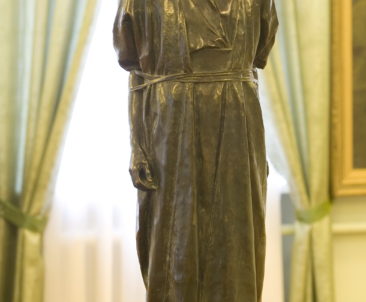

The future sculptor was born November 2, 1843 in the family innkeeper. The childhood of Mark Matveyevich was not an easy one. Here is how the sculptor himself spoke about him: “My childhood is too gloomy, so gloomy that I remember with a shudder. I was an unloved child, and I got it from everyone. Who wanted to beat me, even the servants; and no one caressed me. I was wearing old clothes, they called me “idol”, “tin hands”. I celebrated the position of a workhorse in the family. My mother did not humiliate me. “
Parents treated his son’s enthusiasm for drawing sharply negative, but despite this they arranged the boy as an apprentice to a wood carver. His work impressed the governor of Vilnius VI. Nazimova, and he contributed to the arrival of Mark Antokolsky in the Academy of Arts.
The sculptor not only learned Russian, but also became interested in Russian culture and history. The first large work of Antonokol “Ivan the Terrible” was a huge success and was acquired by Alexander II for the Hermitage. Later the master created many images from Russian history, such as: Nestor the chronicler, Ermak, Yaroslav the Wise.
In the Voronezh Regional Art Museum. In. N. Kramskoy sculpture “Christ before the people’s court” is made in bronze.
The sculptor himself spoke about his work: “I chose this moment because here the knot of drama was contacted, his mental movement at this moment is unusually grandiose.” Jesus appears in front of the viewer in full growth with his hands tied behind his back. He is outwardly calm, but behind this calmness lies true strength, determination and deep humanity. “In the statue I wanted to create silence and depth, external simplicity with inner depth …” – wrote the sculptor.
Europe enthusiastically accepted the work of Mark Matveyevich. At the World Exhibition in 1878 in Paris for the sculpture “Christ before the people’s court” he received a medal and the Order of the Legion of Honor. In Russia critics have reacted to the work very critically. However, despite numerous negative reviews, there were those who appreciated the author’s innovation. For example, Repin, Turgenev and Stasov called the sculpture a genius.
Antokolsky considered himself a Russian artist: “All my soul belongs to the country where I was born and with whom I got used. In the north my heart beats harder. I breathe more deeply there and more sensitive to everything that happens there. That’s why, no matter what I do, it will always be the result of those heartfelt impressions with which Mother Rus has nurtured, “Antokolsky wrote to V.Stasov.
But in 1893, Antokolsky left Russia forever. By his departure, he was pushed by the progressive deterioration of his health and the failure of his personal exhibition at the Petersburg Academy of Arts. Since 1897, he spent part of his time in Italy on Lake Maggiore, but still, in the priority for him remained work in Paris.
Antokolsky died July 9, 1902 in Frankfurt am Main in Germany from lung disease. He was buried by a famous sculptor in Russia in St. Petersburg, at the Jewish Transfiguration Cemetery.